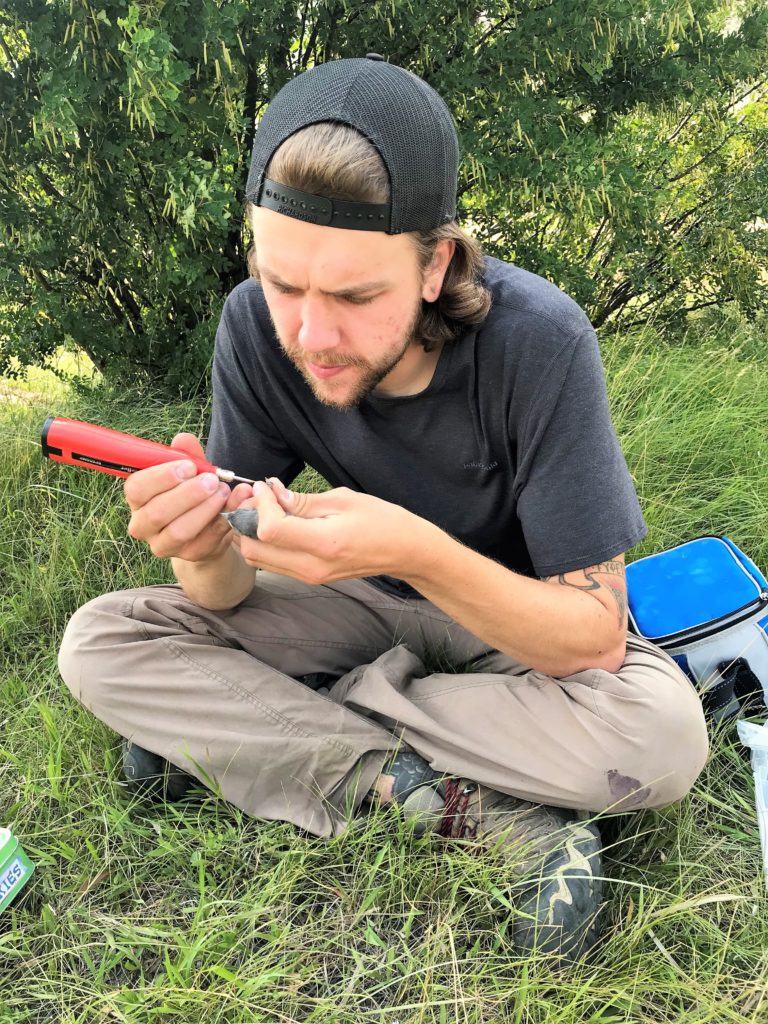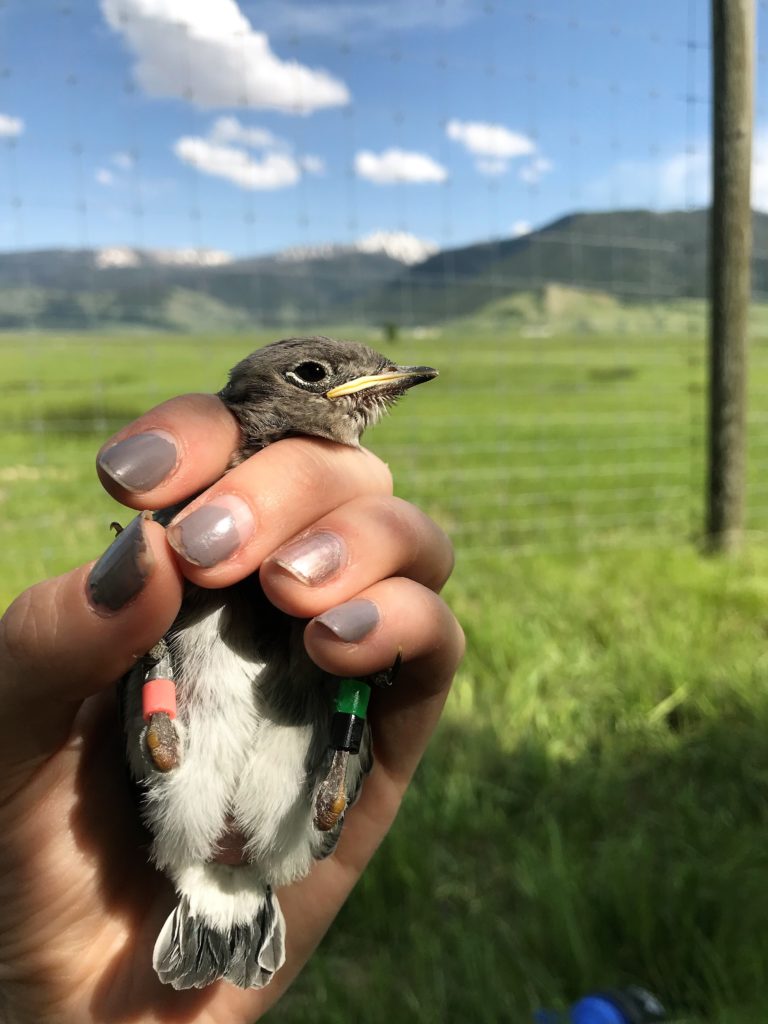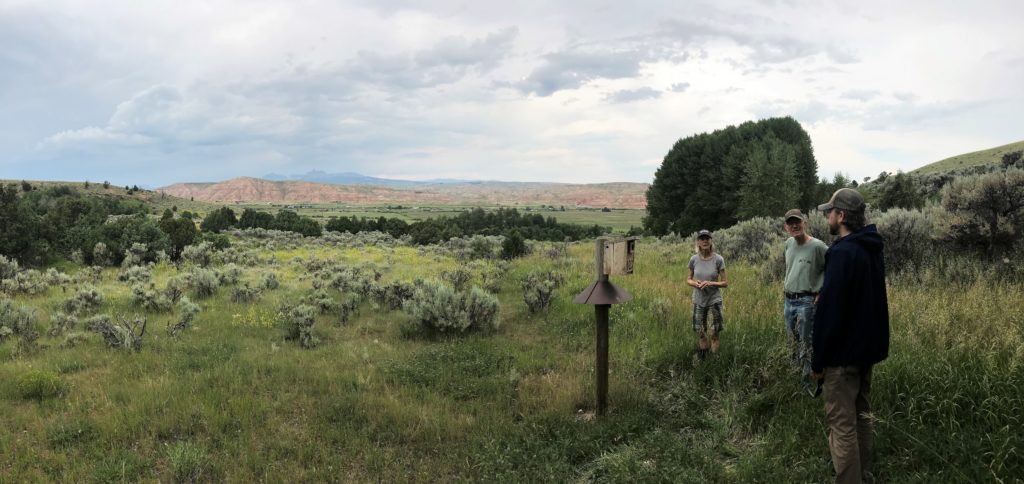by Kate Maley, Lead Bird Bander
Since Chuck Schneebeck started the Bluebird Trail in 2003, members of the Jackson community have endeavored to create nesting habitat for Mountain Bluebirds and other native cavity-nesters along the southwestern edge of the National Elk Refuge. After many years of observation and data collection, at least one thing is clear: the birds are definitely using the nestboxes! But what effect are the boxes having on the population?

While we focus on Mountain Bluebirds, we are equally pleased to see other native cavity nesters using the nestboxes! Tree Swallows are the most abundant nesters along the Bluebird Trail, though they arrive after most bluebirds have settled into their territories for the season.
Jackson Update:
In 2017, JHWF began expanding upon the existing data and investigating new questions when our previous bander Allison Swan and monitoring volunteers started placing USGS aluminum bands and a unique series of color bands on Mountain Bluebird nestlings and one adult female. These color bands, or “bling,” allow us to identify each individual bird as it disperses from its nest and, hopefully, returns to a similar area the following year to raise some little bluebirds of its own!
Still in the early stages of the banding project, we don’t have many definitive answers yet, but we are learning lots! Of the 98 bluebird nestlings that were banded in 2017, only a handful have been resighted this year. This isn’t as surprising as it may initially sound, however. The first year of a bird’s life is the hardest as they learn to fend for themselves and navigate migration. Optimistically, we estimate that around 50% or fewer birds make it back to their breeding grounds in their second year. Once back in Jackson Hole, they disperse from their original nest site to independently begin a family of their own. Where do they go? That’s one of the things we’re hoping to discover!

Max Frankenberry, Assistant Bander, secures the color bands on a nestling to help ensure they will stay on and be able to be spotted next year.
While migration is still a taxing journey for adult bluebirds, they do benefit from experience. In addition, adult bluebirds tend to have higher site fidelity, meaning they are more likely to return to the same site to breed for multiple years. So far, the one banded adult mountain bluebird did, in fact, return to the exact same nestbox where she was banded in 2017!
Admittedly, 2018 was a tough year for nestbox inhabitants as almost half of the nestboxes were within a stretch affected by predation events. (Exact numbers are still being determined as we close out the season and compile the data.) In response, we placed a number of predator guards that are recommended by the North American Bluebird Society. Fortunately, most of the guards did seem to effectively prevent the depredation of a second nesting attempt. Even with the challenge of a predator, nearly all of the 112 available nestboxes were occupied by native cavity nesters (Mountain Bluebirds, Tree Swallows and House Wrens). Of the Mountain Bluebird nests, about 75% successfully fledged young. In total, 72 nestlings were banded in 13 nestboxes (some had two broods throughout the season).
Now, we’ve reached the point in the season when bluebirds of all ages disperse from their nest sites and seem to gather into groups by age to take advantage of the last of summer’s bounty and fatten up before migration. So, if you keep an eye out for “Bluebirds with Bling,” you’re likely to see some from the 2018 cohort (indicated by a peach color band on the bird’s right leg, closest to the body) and possibly some from 2017 as they group up prior to beginning journey south.

Meet one of the members of 2018’s cohort of bluebirds! The location of the peach color band (top right) will allow us to easily identify it as having hatched and been banded this year. Left: Black over Green, Right: Peach over Silver
Dubois Update:
Last year was also the first year of the Dubois Community Bluebird Trail. The project continued in 2018 with 35 nestboxes monitored by 9 volunteers. We’re still waiting to finalize the data prior to analyzing the results from the season, but we’re looking forward to what we find out!
Thank you to all our hardworking volunteers and partners in both Jackson and Dubois who make this project possible!

Nancy and Blair Butterfield were kind enough to give us an update and tour of their nestboxes when we visited Dubois in July.
